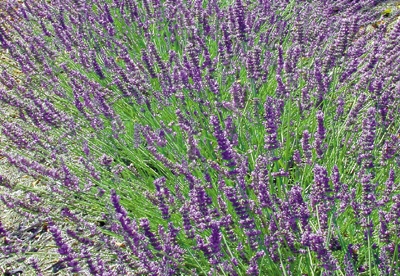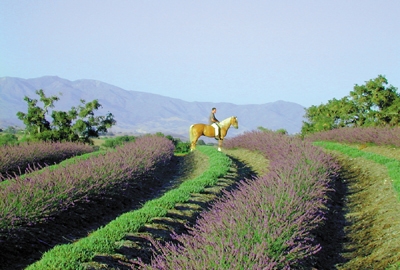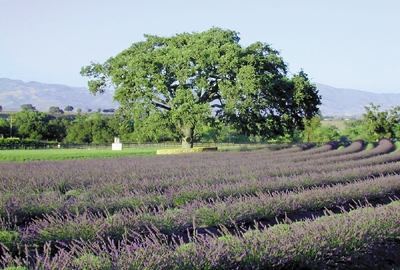Having grown up in a small town in Texas populated almost exclusively by farmers and ranchers, I know the challenges and hardships that farmers can sometimes face. Consequently, I'm intrigued when I learn of anything that portrays the romance in farming. In California and the western states, the last decade or so has certainly rekindled the yearning for rural lifestyle, and the desire to own some amount of acreage that could potentially be planted to something. In the last decade, there has been almost a consensus that having one's own vineyard would be a dream come true. Now a new romance may be on the horizon. Fields aglow in a lavender mist are beginning to appear in areas of the western United States most conducive to its growth - that is, Mediterranean climates with warm summers and cool dry winters.
Lavender is by no means new to the world markets. It is cultivated commercially in France, England, Argentina, Brazil, Bulgaria, Cyprus, Greece, Hungary, Italy, Japan, Russia, Spain, Tanganyika, Turkey, Croatia, Australia, Tasmania, and New Zealand. Lavender grows wild in the south of France, on the Island of Corsica, and in Italy and Croatia. France is the largest grower with annual production varying from about fifty metric tons to almost one hundred tons. Japan produces two to three metric tons per year which is far from sufficient for its own needs, and even the Russian production does not cover local consumption.

The quintessential lavender romance is found in the South of France, in Provence, where the fragrance of lavender is synonymous with summer. Lavender first blooms in Provence in June and is gathered in July or August. Fresh bouquets fill the markets; flower festivals and craft fairs are held in village streets in the perfume laden air. The cultivated lavender fields amidst the olive groves and vineyards were a source of inspiration for the nineteenth century French Impressionist artists such as Claude Monet and Paul Gaugin.
The United States is somewhat of a newcomer to the commercial production of lavender. Sequim Washington was proclaimed the lavender capital of the U. S., with its favorable geographic location protected by the Olympic Mountains that gives it a Mediterranean climate. But in the last few years, lavender has caught on in California. In the wine regions such as Napa and Sonoma in northern California, and the Santa Ynez Valley to the south, some select locations offer a Provencal appearance with vineyards, olive groves, and fields of purple lavender. This newfound proliferation in areas where vineyard planting has become almost prosaic give us evidence that there must be demand for this herb and the products of its harvest.

Lavender is a member of the Lamiaceae family, which also includes sage, thyme, savory, and oregano. An evergreen shrub, two to four feet in height, lavender blooms with violet to deep purple blossoms that grow in a tight swirl around the stalk. The herb has a clean fresh soothing fragrance with woody and camphoric overtones. When harvested, the blossoms drop off leaving the bluish lavender buds that cluster tightly against the stem. The bud-covered stems bunched together make a bouquet that is lovely by itself or as an accent to other floral arrangements. A sprig of lavender at every place setting is a trendy signature of summer entertaining. The bud-covered stems can also be dried; they retain their purple color and can be used long term. The buds alone make excellent potpourri and sachets, and can also be brewed in teas (lavender is edible.) Yet most in demand is the oil. Lavender buds are steam distilled to produce the yellowish green essential oil of lavender, which is the primary ingredient in a wide array of products.
Lavender oil is the most dominant oil used in perfumes. It can also be used for skin conditioners, body lotions, bath soaps, candles, deodorizers, laundry soaps, and household cleansers. A wide array of far-reaching claims about the benefits of lavender include that it reduces dandruff when used in shampoos, calms and soothes the skin and balances oil production, helps heal blemishes and stimulate circulation to the skin, reduces acne and eczema, heals burns and sunburn, and alleviates the effects of bee stings. It is known to have mild antiseptic and antibiotic properties that can kill bacteria. Lavender is a natural insect repellent, and it is used as sachets in clothing closets to ward off moths, and as a repellent for fleas and flies. Some claim that lavender ;can suppress sprouting in potatoes, and that the fragrance of lavender is calming to horses.
s to obtain this calming and balancing effect. Essential oil of lavender is even used as flavoring for various foods, including beverages, ice cream, candy, baked goods, and chewing gum. Lavender honey is gathered from bees that feed on blooming lavender.
Some of the purported "medicinal" benefits of lavender are that it calms the nerves, balances emotions, prevents insomnia, and alleviates fear and irritability and stress. Claims are made that it clears the thinking and strengthens the nervous system, and that it benefits those who suffer from hyperglycemia, hypertension, indigestion, arteriosclerosis, digestive complaints, kidney stones, fragile capillaries, anemia, and heartburn. It is also supposedly effective in reducing caffeine-induced hyper-activity, in relieving headaches, in promoting deeper and longer sleep, and in alleviating motion sickness. Such "medicinal" uses of lavender have been popularized by an alternative healing technique known as aromatherapy.
Aromatherapy is a term for the practice of using essential oils taken from plants to bring healing and balance to the body. In fact, the term aromatherapy owes its existence to lavender. The term was coined in 1928 by the French chemist Gattefossé , after he accidentally discovered that the use of oil of lavender caused a severe burn on his hand to heal, and without scarring. In aromatherapy, the aroma itself does not bring the cure, but rather it serves to stir cell-level memories in the body that can bring about greater balance and well-being. The theory is that olfactory cilia transmit to the brain's limbic cortex, which regulates the secretion of pituitary hormones. Some aromatherapists claim that inhaling essential oil of lavender or allowing it be absorbed through the skin causes serotonin to be released, producing a calming influence.
Like wine grapes, most lavenders are natives of the Mediterranean countries. Lavender was perhaps first cultivated in Persia. The early Egyptians believed that fragrances were emanations from deities, and they wrapped their dead in lavender-dipped shrouds. There are theories held by some Egyptologists that the Temple of Luxor reflects the anatomical structure of the nasal cavity, with secret sanctuary chambers representing the olfactory, pineal and pituitary glands in the human head.
The Ancient Greeks used lavender to fight insomnia, insanity and aching backs. The Greek naturalist, Dioscorides, praised the medicinal attributes of lavender in the first century A.D. Lavender is referred to in the Bible by the name of "spikenard." In John, Chapter 12, Mary is said to have anointed the feet of Jesus with the "very costly" "ointment of spikenard." In further discussion of selling the ointment , Jesus states that the ointment was not to be sold but was to be kept for the day of His burying. The Romans used lavender in soaps, and carried it with them throughout the Roman Empire for bathing purposes. The name lavender was coined during the Middle ages and derives from the Latin verb lavare - which means, "to wash."
In Medieval and Renaissance Europe, the washing women were known as "lavenders." They used lavender to scent drawers and they dried the laundry on lavender bushes. Lavender was also used as a plague remedy. In the nineteenth century, Queen Victoria took an interest in lavender, and English lavender became popular. The Victorians used lavender for gardens, and were the first to bring the plant inside. During World War I, lavender moved to the front lines and was used as an antiseptic. Lavender was discovered to be good for skin wounds and burns, a remedy for bug bites, and a general panacea to help the skin heal more quickly.

Clearly the recent interest in lavender represents a rebirth of what was once the rage! There can be no doubt of lavender's present popularity. In 1999, lavender was named herb of the year by the International Herb Association. A year ago, Virgil Elings planted seven acres of lavender on his 65-acre ranch in the Santa Ynez Valley. When asked why he chose to plant lavender, Elings says, "I didn't want to plant more grapes. I wanted something that would be drought tolerant and low maintenance, but that would at the same time have good commercial value. Lavender was the answer."
Lavender can be planted anywhere in rock and flower gardens as an annual plant. But in appropriate climates, it is a long-lived perennial with a typical productive life of about ten years, although plants have been known to live twenty years. There are a number of varieties of lavender and therefore there is some variety in the growing conditions required. All varieties have in common the need for lots of sun and well-drained soil that is slightly alkaline. Lavender doesn't require a lot of water except in the early stages. The plant does not like to have "wet feet."
Cultivated lavender is planted as seedlings, rather than being planted as seeds in the ground. Making a selection of the species of lavender from the many varieties is based on climate and soil conditions of the growing location, and on intended use of the harvest. Lavenders vary in color, fragrance, taste, and size; there are some lavenders that won't tolerate harsh winters and some that will, some lavenders that sprawl more than others, some that are easier to harvest than others, some that bloom earlier than others. Within the various species of lavender there are cultivars of lavender. Cultivars are variations on the same species. When growing for commercial purposes, one must first select the desired species, but it is also essential that the correct cultivars are planted. One of the most common cultivars is a "lavendin" known as "lavender grosso." This variety has gorgeous color, and wonderful scent, and an abundance of oil. There are numbers of books available on the subject of growing lavender and selection of varieties. But the best way to learn the nuances of the different varieties is to grow them yourself, or visit someone who does. After all, at the end of the day, lavender is really all about the experience of lavender. |